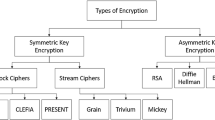Abstract
A visually secure multiple image encryption using chaotic map and compressive sensing is proposed. The existing image encryption algorithms transform a secret image into a random noise like cipher image which can lead to cryptanalysis by an intruder. In the proposed method, compressive sampling is done using a chaos based, key controlled measurement matrix. An image dependent key generation scheme is used to generate the parameters of the chaotic map. The secret images are transformed into wavelet coefficients, and scrambled along a zigzag path, so that the high correlation among them can be reduced and thereby provide increased security level. The sparse coefficients are measured using the chaotic map-based measurement matrix, whose initial parameters are obtained from the keys generated. Then the reduced measurements are embedded into the sub-bands of the wavelet transformed cover image. Therefore, the proposed algorithm is highly sensitive to the secret images and can effectively withstand known-plaintext and chosen-plaintext attacks. Additionally, the cipher image and the secret images are of same size and do not require additional transmission bandwidth and storage space.









Similar content being viewed by others
References
Bao L, Zhou Y (2015) Image encryption: generating visually meaningful encrypted images. In Sci 324:197–207
Cao X, Wei X, Guo R, Wang C (2017) No embedding: a novel image cryptosystem for meaningful encryption. J Vis Commun Image Represent 44:236–249
Chai X, Gan Z, Chen Y, Zhang Y (2017) A visually secure image encryption scheme based on compressive sensing. Signal Process 134:35–51
Dolendro Singh L, Manglem Singh K (2018) Visually meaningful multi-image encryption scheme. Arab J Sci Eng 43:7397–7407
Hu G, Xiao D, Wang Y, Xiang T (2017) An image coding scheme using parallel compressive sensing for simultaneous compression-encryption applications. J Vis Commun Image Represent 44:116–127
Kanso A, Ghebleh M (2017) An algorithm for encryption of secret images into meaningful images. Opt Lasers Eng 90:196–208
Li M, Fan H, Ren H et al (2018) Meaningful image encryption based on reversible data hiding in compressive sensing domain. Secur Commun Netw 2018:1–12
Liao X, Li K, Yin J (2017) Separable data hiding in encrypted image based on compressive sensing and discrete fourier transform. Multimed Tools Appl 76:20739–20753
Ponuma R, Amutha R (2018) Compressive sensing based image compression-encryption using novel 1D-chaotic map. Multimed Tools Appl 77:19209–19234
Ponuma R, Amutha R (2018) Compressive Sensing and Chaos-Based Image Compression Encryption. In: Advances in Soft Computing and Machine Learning in Image Processing. Springer, pp 373–392
Ponuma R, Aarthi V, Amutha R (2016) Cosine Number Transform based hybrid image compression-encryption. In: Proceedings of the 2016 IEEE International Conference on Wireless Communications, Signal Processing and Networking, WiSPNET 2016. pp 172–176
Sreedhanya AV (2013) Ensuring security to the compressed sensing data using a Steganographic approach. Bonfring Int J Adv Image Process 3:01–07
Thanki R, Borra S, Dwivedi V, Borisagar K (2017) A steganographic approach for secure communication of medical images based on the DCT-SVD and the compressed sensing (CS) theory. Imaging Sci J 65:457–467
Wang H, Xiao D, Li M et al (2019) A visually secure image encryption scheme based on parallel compressive sensing. Signal Process 155:218–232
Wen W, Zhang Y, Fang Y, Fang Z (2018) Image salient regions encryption for generating visually meaningful ciphertext image. Neural Comput Appl 29:653–663
Xiao M, He Z (2015) High capacity image steganography method based on framelet and compressive sensing. In: MIPPR 2015: Multispectral Image Acquisition, Processing, and Analysis. p 98110Y
Xiao D, Cai H, Wang Y, Bai S (2016) High-capacity separable data hiding in encrypted image based on compressive sensing. Multimed Tools Appl 75:13779–13789
Yu L, Barbot JP, Zheng G, Sun H (2010) Compressive sensing with chaotic sequence. IEEE Sign Proc Lett 17:731–734
Zhang Y, Zhou J, Chen F, Zhang LY, Wong KW, He X, Xiao D (2016) Embedding cryptographic features in compressive sensing. Neurocomputing 205:472–480
Zhang D, Liao X, Yang B, Zhang Y (2018) A fast and efficient approach to color-image encryption based on compressive sensing and fractional Fourier transform. Multimed Tools Appl 77:2191–2208
Zhou N, Zhang A, Zheng F, Gong L (2014) Novel image compression-encryption hybrid algorithm based on key-controlled measurement matrix in compressive sensing. Opt Laser Technol 62:152–160
Author information
Authors and Affiliations
Corresponding author
Additional information
Publisher’s note
Springer Nature remains neutral with regard to jurisdictional claims in published maps and institutional affiliations.
Rights and permissions
About this article
Cite this article
Ponuma, R., Amutha, R., Aparna, S. et al. Visually meaningful image encryption using data hiding and chaotic compressive sensing. Multimed Tools Appl 78, 25707–25729 (2019). https://doi.org/10.1007/s11042-019-07808-6
Received:
Revised:
Accepted:
Published:
Issue Date:
DOI: https://doi.org/10.1007/s11042-019-07808-6




